Coal Mining: Safety Management System, Risk Assessment, and Prevention
VerifiedAdded on 2023/06/12
|10
|2153
|303
AI Summary
This article discusses the safety management system, risk assessment, and prevention in coal mining. It also covers the incidents that resulted in fatalities at the underground Moura coal mine and how to prevent them. Additionally, it provides a spreadsheet showing the ore reserves (tonnages and grade).
Contribute Materials
Your contribution can guide someone’s learning journey. Share your
documents today.

Coal mining 1
COAL MINING
by (Name)
Name of the class (course)
Professor (tutor)
Name of the school (university)
The city and state where it is located
Date
COAL MINING
by (Name)
Name of the class (course)
Professor (tutor)
Name of the school (university)
The city and state where it is located
Date
Secure Best Marks with AI Grader
Need help grading? Try our AI Grader for instant feedback on your assignments.

Coal mining 2
Basic elements that a coal mine’s safety management system must provide
A safety management system (SMS) like the name suggest provides a methodical approach to
dealing with safety issues as well as the required procedures, policies, accountabilities and
organizational structures (Government of Western Australia, 2014). In this case we consider a
management system functioning at a mine.
i. The possible hazards should be analyzed and provided by the management of the mines.
ii. A report in a recorded form should be given by the management in accordance to the
health and safety of the miners (Gunningham, 2007).
iii. Identifying and assessment of possible risks should be carried out by the management.
iv. Management and control of the problems identified should be considered by the
management.
Requirements of site senior executive (SSE) in relation to risk assessments
i. Regards to the hazardous features around the mining site should be regarded to avoid
interfering with them (Huan, et al., 2012).
ii. projects taking place near or proposed near the mining area should be risk assessed for
safety purposes (Graebner, 2015).
iii. The stability properties of the pillar should be looked into.
iv. Presence of any gas should be highlighted so that any hazards that they might cause are
assessed.
v. Geological structure in accordance to workings proposed should be considered during
risk assessment.
Basic elements that a coal mine’s safety management system must provide
A safety management system (SMS) like the name suggest provides a methodical approach to
dealing with safety issues as well as the required procedures, policies, accountabilities and
organizational structures (Government of Western Australia, 2014). In this case we consider a
management system functioning at a mine.
i. The possible hazards should be analyzed and provided by the management of the mines.
ii. A report in a recorded form should be given by the management in accordance to the
health and safety of the miners (Gunningham, 2007).
iii. Identifying and assessment of possible risks should be carried out by the management.
iv. Management and control of the problems identified should be considered by the
management.
Requirements of site senior executive (SSE) in relation to risk assessments
i. Regards to the hazardous features around the mining site should be regarded to avoid
interfering with them (Huan, et al., 2012).
ii. projects taking place near or proposed near the mining area should be risk assessed for
safety purposes (Graebner, 2015).
iii. The stability properties of the pillar should be looked into.
iv. Presence of any gas should be highlighted so that any hazards that they might cause are
assessed.
v. Geological structure in accordance to workings proposed should be considered during
risk assessment.

Coal mining 3
vi. The extractions anticipated sequence and method considerations should be assessed.
vii. Assessment on the method used for ventilation, developing combustion method used in
controlling it, support and strata should be also looked into (Cheng, 2018).
viii. Responsibility on the methods used in supporting the mining activities should be covered
for the area of golf edges.
ix. The fitness of the plant should also be looked into to be aware of its controls.
Incidents that resulted in fatalities at the underground Moura coal mine
36 lives have been lost in catastrophes that were experienced three times in Moura district
(Dhilon, 2010). In 1975, 13 lives were claimed which was the first disaster that took place in
Kianga Mine. A continuous burning was caused by an explosion which occurred in the year
1986, 12 lives were lost due to the second disaster that occurred at mine No 4 in Moura (Bell,
2012). It is said that the explosion may have been caused by ignition caused by friction or a
flame safety lamp. Lastly 11 lives were claimed in the year 1994 at mine No 2 where my
investigation is focused (The Observer, 2014).
Out of 21 men who were working underground only 10 were able to escape and reach the surface
when there was a first explosion in mine No 2. Attempts were made to rescue and recover the
miners but later on an explosion occurred more violently resulting to abandoning the rescue
activity (Brune, 2010). Efficient prevention of the coal heating and failure of identity were the
causes which made explosions to begin from 512 Panel. Ignition was caused by methane that
accumulated resulting to a big explosion in the panel (Smith, 2016).
The fatalities caused in the mines may have also been driven by other factors apart from the main
explosion:
vi. The extractions anticipated sequence and method considerations should be assessed.
vii. Assessment on the method used for ventilation, developing combustion method used in
controlling it, support and strata should be also looked into (Cheng, 2018).
viii. Responsibility on the methods used in supporting the mining activities should be covered
for the area of golf edges.
ix. The fitness of the plant should also be looked into to be aware of its controls.
Incidents that resulted in fatalities at the underground Moura coal mine
36 lives have been lost in catastrophes that were experienced three times in Moura district
(Dhilon, 2010). In 1975, 13 lives were claimed which was the first disaster that took place in
Kianga Mine. A continuous burning was caused by an explosion which occurred in the year
1986, 12 lives were lost due to the second disaster that occurred at mine No 4 in Moura (Bell,
2012). It is said that the explosion may have been caused by ignition caused by friction or a
flame safety lamp. Lastly 11 lives were claimed in the year 1994 at mine No 2 where my
investigation is focused (The Observer, 2014).
Out of 21 men who were working underground only 10 were able to escape and reach the surface
when there was a first explosion in mine No 2. Attempts were made to rescue and recover the
miners but later on an explosion occurred more violently resulting to abandoning the rescue
activity (Brune, 2010). Efficient prevention of the coal heating and failure of identity were the
causes which made explosions to begin from 512 Panel. Ignition was caused by methane that
accumulated resulting to a big explosion in the panel (Smith, 2016).
The fatalities caused in the mines may have also been driven by other factors apart from the main
explosion:

Coal mining 4
a) Failure to stop the heat that was developing. The coal left loosely behind may be
the main cause of the heat growth thereafter. Failure of coal ventilation due to the
fall covering some coal that was loose after the mining process since the roof was
unsupported. Heat was also cultivated and encouraged by the insufficient
ventilation in some places in the goaf which caused a lot of heat (Peetz &
Murray , 2010).
b) Inadequate knowledge on developing heat in the mine by the miners since they
did not recognize that there was a developing heat in the mine (Yang, 2011). The
fact is that the small knowledge they had, was not fully applied in their activities.
They did not use the available tools they had effectively since the on-site
chromatograph was never used before the explosion because it provided
information on the 512 panel (Quinlan, 2014).
c) Methane that accumulated was not sealed therefore it accumulated in the panel
causing heat. There was a need to seal methane that was accumulating in the
panel where mining had taken place to curb explosion in case of the developing
heat which was not done since there existed a leak in the panel which contributed
to the explosion after coal heating took place after the mining process (Scott,
2012).
d) Lack of evaluation skills, capturing many tell-tale signs used in the mines and also
lack of proper communication while at work. The response team failure in
communicating to the working team was the main reason that caused loose of
opportunities in the reporting channel. There was no response also when there
a) Failure to stop the heat that was developing. The coal left loosely behind may be
the main cause of the heat growth thereafter. Failure of coal ventilation due to the
fall covering some coal that was loose after the mining process since the roof was
unsupported. Heat was also cultivated and encouraged by the insufficient
ventilation in some places in the goaf which caused a lot of heat (Peetz &
Murray , 2010).
b) Inadequate knowledge on developing heat in the mine by the miners since they
did not recognize that there was a developing heat in the mine (Yang, 2011). The
fact is that the small knowledge they had, was not fully applied in their activities.
They did not use the available tools they had effectively since the on-site
chromatograph was never used before the explosion because it provided
information on the 512 panel (Quinlan, 2014).
c) Methane that accumulated was not sealed therefore it accumulated in the panel
causing heat. There was a need to seal methane that was accumulating in the
panel where mining had taken place to curb explosion in case of the developing
heat which was not done since there existed a leak in the panel which contributed
to the explosion after coal heating took place after the mining process (Scott,
2012).
d) Lack of evaluation skills, capturing many tell-tale signs used in the mines and also
lack of proper communication while at work. The response team failure in
communicating to the working team was the main reason that caused loose of
opportunities in the reporting channel. There was no response also when there
Secure Best Marks with AI Grader
Need help grading? Try our AI Grader for instant feedback on your assignments.

Coal mining 5
was need from the assigned personnel since the person did not pay attention to the
same information (Cepin & Bris, 2017).
e) Failure in the attempt in saving the miners in case of an emergency as soon as it is
about to happen It was never decided whether the workers were to evacuate or
still remain at the site which was inappropriate (toft & Reynolds, 2016).
was need from the assigned personnel since the person did not pay attention to the
same information (Cepin & Bris, 2017).
e) Failure in the attempt in saving the miners in case of an emergency as soon as it is
about to happen It was never decided whether the workers were to evacuate or
still remain at the site which was inappropriate (toft & Reynolds, 2016).
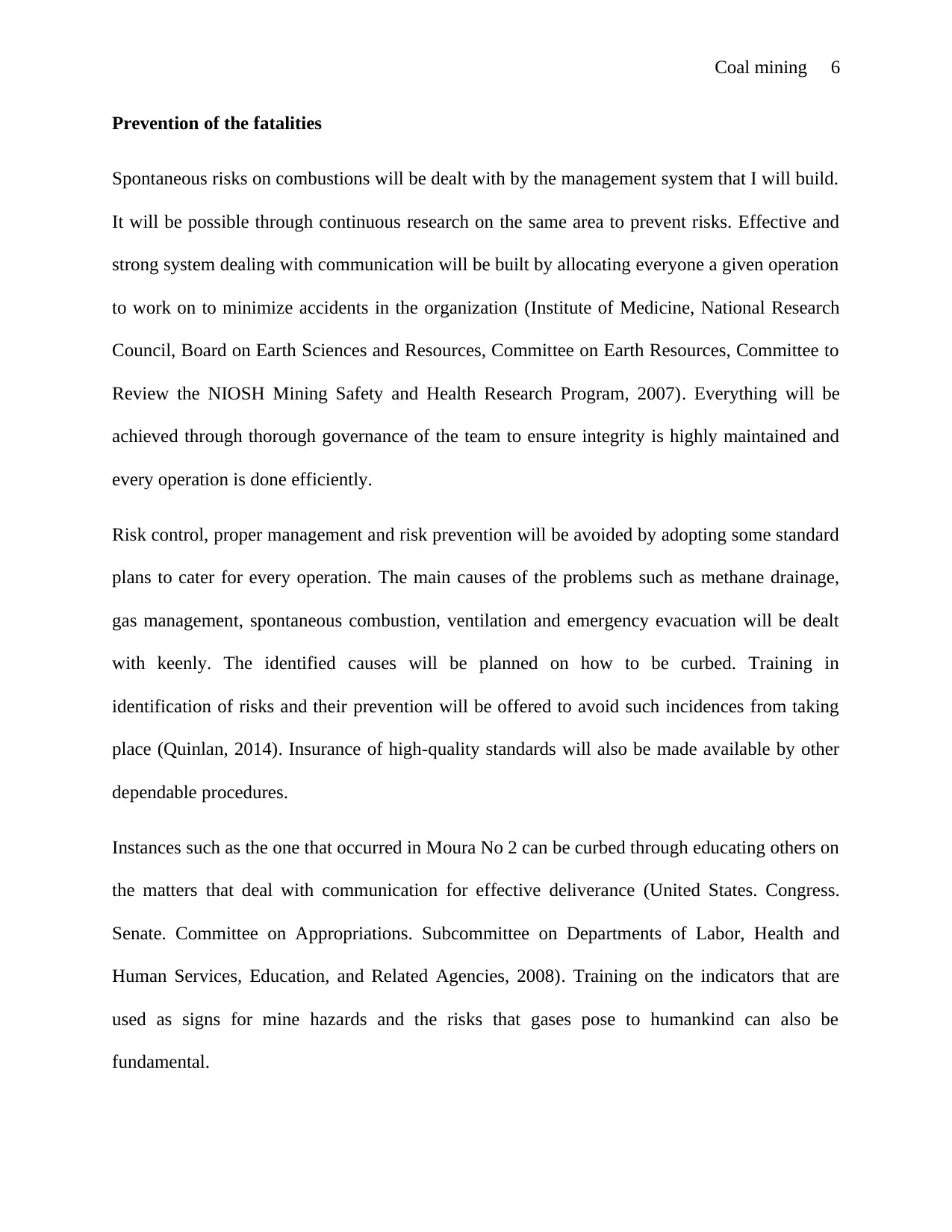
Coal mining 6
Prevention of the fatalities
Spontaneous risks on combustions will be dealt with by the management system that I will build.
It will be possible through continuous research on the same area to prevent risks. Effective and
strong system dealing with communication will be built by allocating everyone a given operation
to work on to minimize accidents in the organization (Institute of Medicine, National Research
Council, Board on Earth Sciences and Resources, Committee on Earth Resources, Committee to
Review the NIOSH Mining Safety and Health Research Program, 2007). Everything will be
achieved through thorough governance of the team to ensure integrity is highly maintained and
every operation is done efficiently.
Risk control, proper management and risk prevention will be avoided by adopting some standard
plans to cater for every operation. The main causes of the problems such as methane drainage,
gas management, spontaneous combustion, ventilation and emergency evacuation will be dealt
with keenly. The identified causes will be planned on how to be curbed. Training in
identification of risks and their prevention will be offered to avoid such incidences from taking
place (Quinlan, 2014). Insurance of high-quality standards will also be made available by other
dependable procedures.
Instances such as the one that occurred in Moura No 2 can be curbed through educating others on
the matters that deal with communication for effective deliverance (United States. Congress.
Senate. Committee on Appropriations. Subcommittee on Departments of Labor, Health and
Human Services, Education, and Related Agencies, 2008). Training on the indicators that are
used as signs for mine hazards and the risks that gases pose to humankind can also be
fundamental.
Prevention of the fatalities
Spontaneous risks on combustions will be dealt with by the management system that I will build.
It will be possible through continuous research on the same area to prevent risks. Effective and
strong system dealing with communication will be built by allocating everyone a given operation
to work on to minimize accidents in the organization (Institute of Medicine, National Research
Council, Board on Earth Sciences and Resources, Committee on Earth Resources, Committee to
Review the NIOSH Mining Safety and Health Research Program, 2007). Everything will be
achieved through thorough governance of the team to ensure integrity is highly maintained and
every operation is done efficiently.
Risk control, proper management and risk prevention will be avoided by adopting some standard
plans to cater for every operation. The main causes of the problems such as methane drainage,
gas management, spontaneous combustion, ventilation and emergency evacuation will be dealt
with keenly. The identified causes will be planned on how to be curbed. Training in
identification of risks and their prevention will be offered to avoid such incidences from taking
place (Quinlan, 2014). Insurance of high-quality standards will also be made available by other
dependable procedures.
Instances such as the one that occurred in Moura No 2 can be curbed through educating others on
the matters that deal with communication for effective deliverance (United States. Congress.
Senate. Committee on Appropriations. Subcommittee on Departments of Labor, Health and
Human Services, Education, and Related Agencies, 2008). Training on the indicators that are
used as signs for mine hazards and the risks that gases pose to humankind can also be
fundamental.
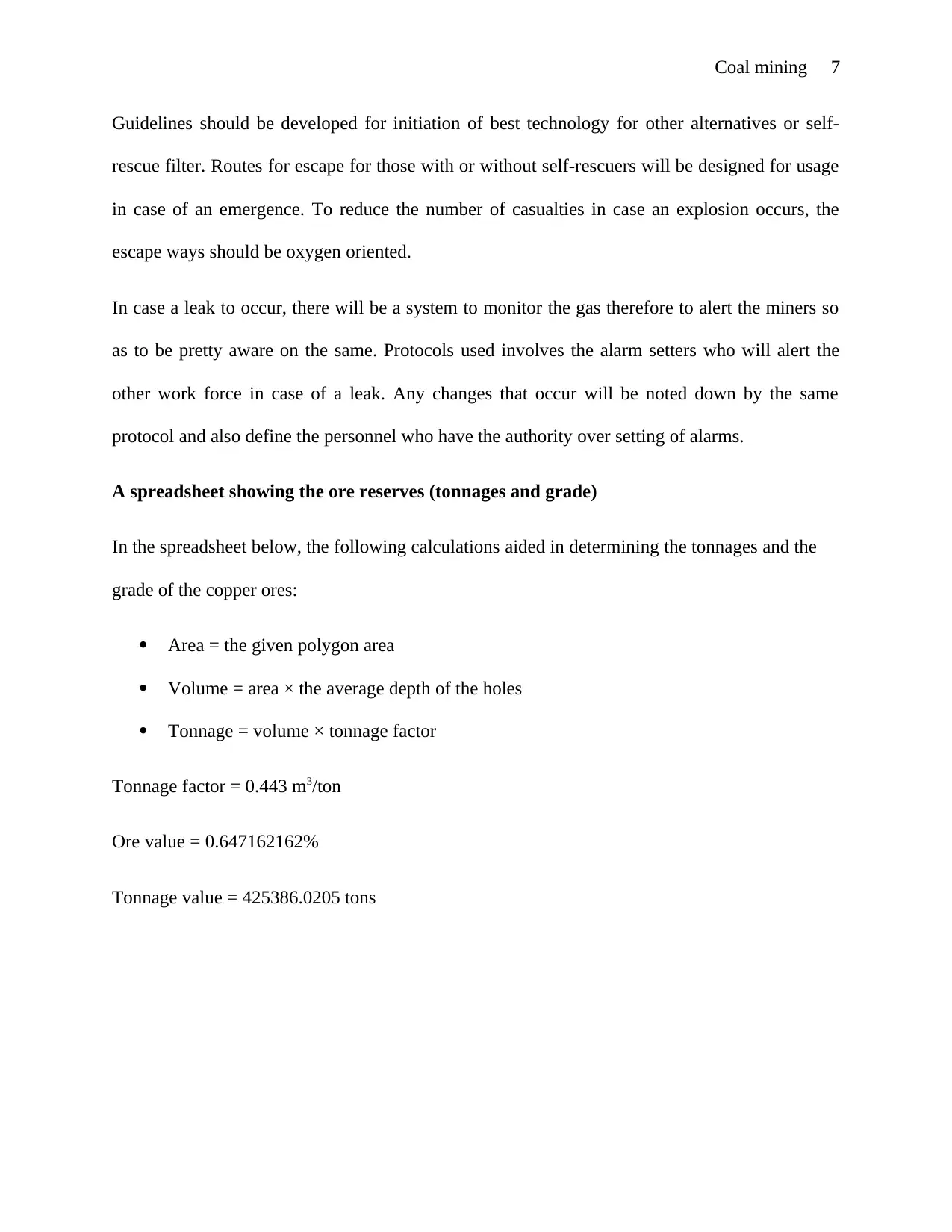
Coal mining 7
Guidelines should be developed for initiation of best technology for other alternatives or self-
rescue filter. Routes for escape for those with or without self-rescuers will be designed for usage
in case of an emergence. To reduce the number of casualties in case an explosion occurs, the
escape ways should be oxygen oriented.
In case a leak to occur, there will be a system to monitor the gas therefore to alert the miners so
as to be pretty aware on the same. Protocols used involves the alarm setters who will alert the
other work force in case of a leak. Any changes that occur will be noted down by the same
protocol and also define the personnel who have the authority over setting of alarms.
A spreadsheet showing the ore reserves (tonnages and grade)
In the spreadsheet below, the following calculations aided in determining the tonnages and the
grade of the copper ores:
Area = the given polygon area
Volume = area × the average depth of the holes
Tonnage = volume × tonnage factor
Tonnage factor = 0.443 m3/ton
Ore value = 0.647162162%
Tonnage value = 425386.0205 tons
Guidelines should be developed for initiation of best technology for other alternatives or self-
rescue filter. Routes for escape for those with or without self-rescuers will be designed for usage
in case of an emergence. To reduce the number of casualties in case an explosion occurs, the
escape ways should be oxygen oriented.
In case a leak to occur, there will be a system to monitor the gas therefore to alert the miners so
as to be pretty aware on the same. Protocols used involves the alarm setters who will alert the
other work force in case of a leak. Any changes that occur will be noted down by the same
protocol and also define the personnel who have the authority over setting of alarms.
A spreadsheet showing the ore reserves (tonnages and grade)
In the spreadsheet below, the following calculations aided in determining the tonnages and the
grade of the copper ores:
Area = the given polygon area
Volume = area × the average depth of the holes
Tonnage = volume × tonnage factor
Tonnage factor = 0.443 m3/ton
Ore value = 0.647162162%
Tonnage value = 425386.0205 tons
Paraphrase This Document
Need a fresh take? Get an instant paraphrase of this document with our AI Paraphraser
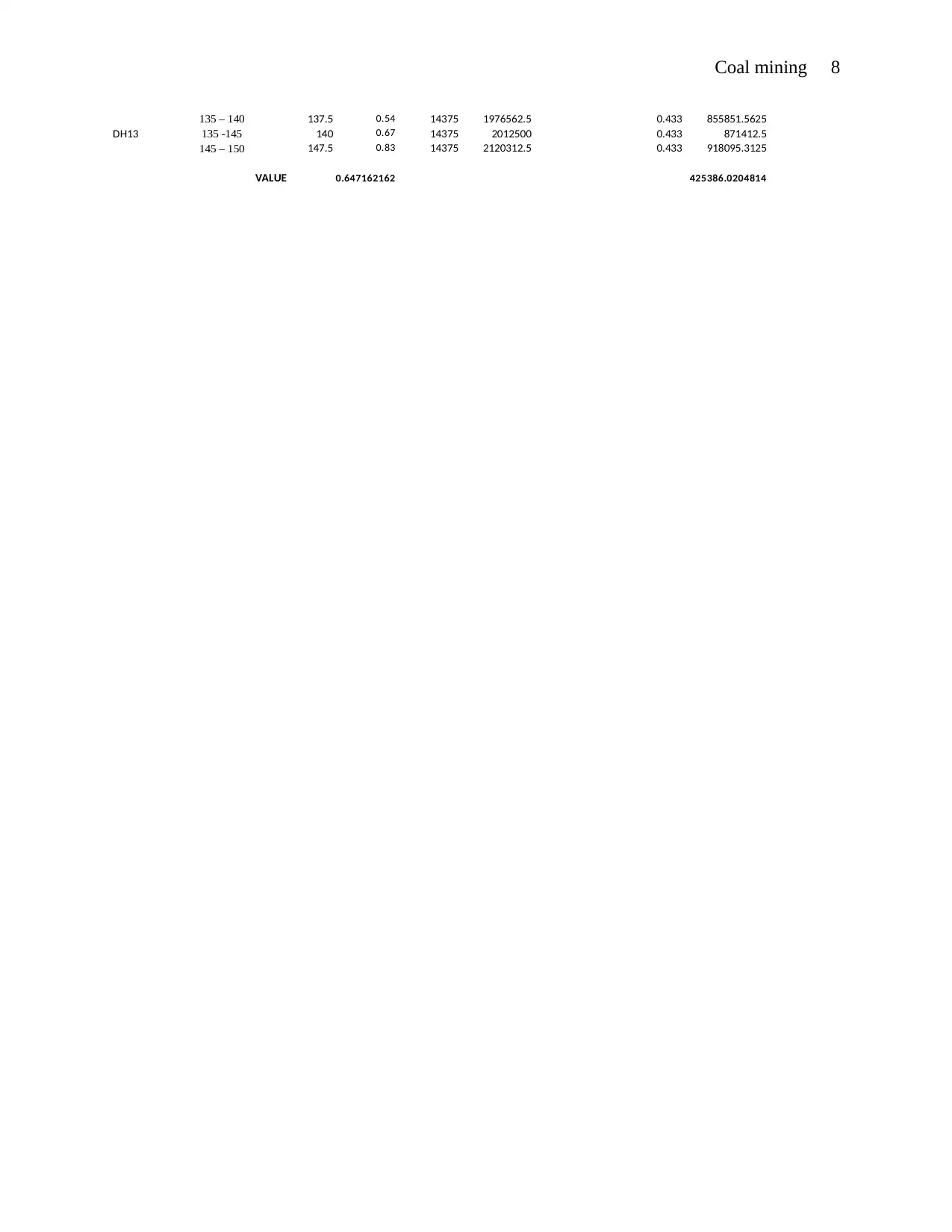
Coal mining 8
135 – 140 137.5 0.54 14375 1976562.5 0.433 855851.5625
DH13 135 -145 140 0.67 14375 2012500 0.433 871412.5
145 – 150 147.5 0.83 14375 2120312.5 0.433 918095.3125
VALUE 0.647162162 425386.0204814
135 – 140 137.5 0.54 14375 1976562.5 0.433 855851.5625
DH13 135 -145 140 0.67 14375 2012500 0.433 871412.5
145 – 150 147.5 0.83 14375 2120312.5 0.433 918095.3125
VALUE 0.647162162 425386.0204814
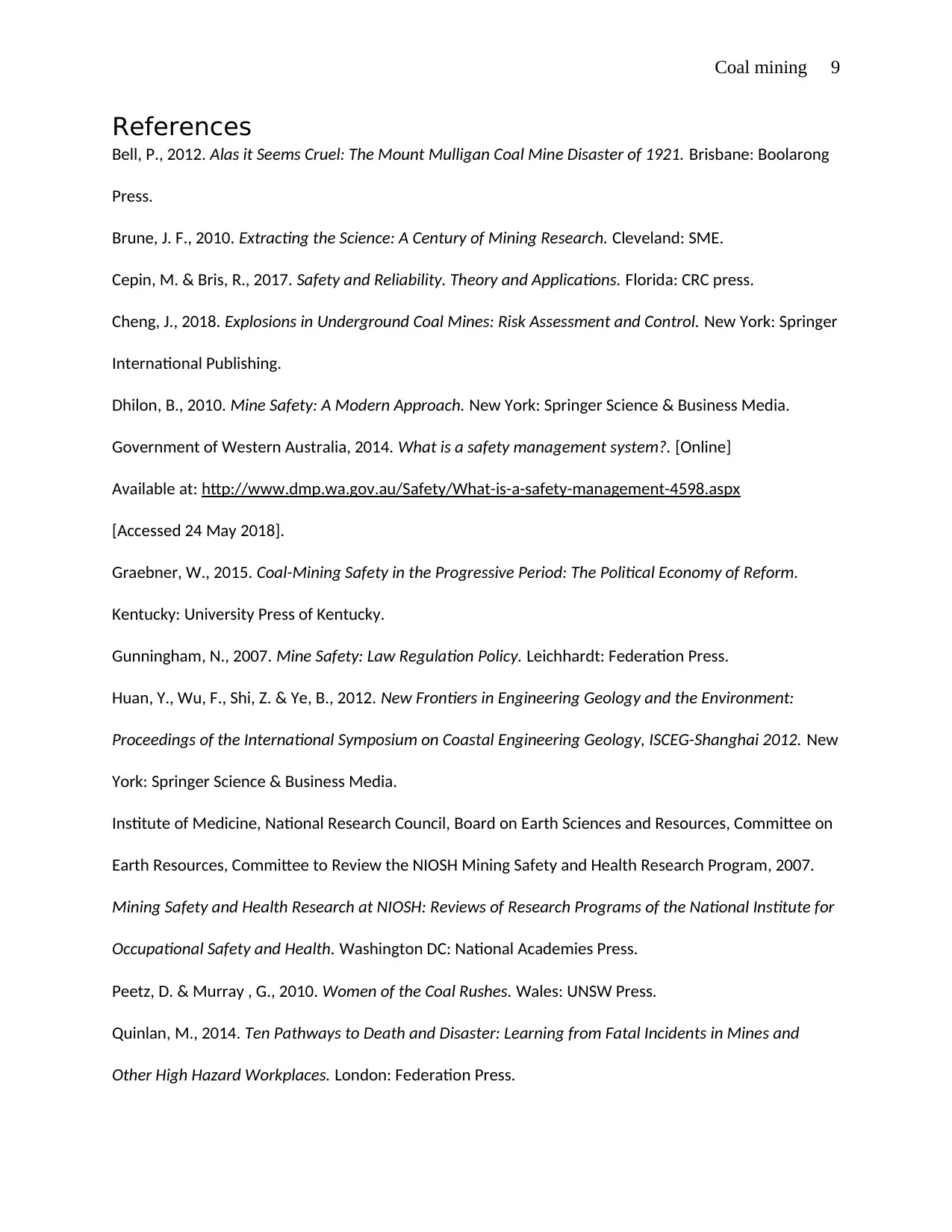
Coal mining 9
References
Bell, P., 2012. Alas it Seems Cruel: The Mount Mulligan Coal Mine Disaster of 1921. Brisbane: Boolarong
Press.
Brune, J. F., 2010. Extracting the Science: A Century of Mining Research. Cleveland: SME.
Cepin, M. & Bris, R., 2017. Safety and Reliability. Theory and Applications. Florida: CRC press.
Cheng, J., 2018. Explosions in Underground Coal Mines: Risk Assessment and Control. New York: Springer
International Publishing.
Dhilon, B., 2010. Mine Safety: A Modern Approach. New York: Springer Science & Business Media.
Government of Western Australia, 2014. What is a safety management system?. [Online]
Available at: http://www.dmp.wa.gov.au/Safety/What-is-a-safety-management-4598.aspx
[Accessed 24 May 2018].
Graebner, W., 2015. Coal-Mining Safety in the Progressive Period: The Political Economy of Reform.
Kentucky: University Press of Kentucky.
Gunningham, N., 2007. Mine Safety: Law Regulation Policy. Leichhardt: Federation Press.
Huan, Y., Wu, F., Shi, Z. & Ye, B., 2012. New Frontiers in Engineering Geology and the Environment:
Proceedings of the International Symposium on Coastal Engineering Geology, ISCEG-Shanghai 2012. New
York: Springer Science & Business Media.
Institute of Medicine, National Research Council, Board on Earth Sciences and Resources, Committee on
Earth Resources, Committee to Review the NIOSH Mining Safety and Health Research Program, 2007.
Mining Safety and Health Research at NIOSH: Reviews of Research Programs of the National Institute for
Occupational Safety and Health. Washington DC: National Academies Press.
Peetz, D. & Murray , G., 2010. Women of the Coal Rushes. Wales: UNSW Press.
Quinlan, M., 2014. Ten Pathways to Death and Disaster: Learning from Fatal Incidents in Mines and
Other High Hazard Workplaces. London: Federation Press.
References
Bell, P., 2012. Alas it Seems Cruel: The Mount Mulligan Coal Mine Disaster of 1921. Brisbane: Boolarong
Press.
Brune, J. F., 2010. Extracting the Science: A Century of Mining Research. Cleveland: SME.
Cepin, M. & Bris, R., 2017. Safety and Reliability. Theory and Applications. Florida: CRC press.
Cheng, J., 2018. Explosions in Underground Coal Mines: Risk Assessment and Control. New York: Springer
International Publishing.
Dhilon, B., 2010. Mine Safety: A Modern Approach. New York: Springer Science & Business Media.
Government of Western Australia, 2014. What is a safety management system?. [Online]
Available at: http://www.dmp.wa.gov.au/Safety/What-is-a-safety-management-4598.aspx
[Accessed 24 May 2018].
Graebner, W., 2015. Coal-Mining Safety in the Progressive Period: The Political Economy of Reform.
Kentucky: University Press of Kentucky.
Gunningham, N., 2007. Mine Safety: Law Regulation Policy. Leichhardt: Federation Press.
Huan, Y., Wu, F., Shi, Z. & Ye, B., 2012. New Frontiers in Engineering Geology and the Environment:
Proceedings of the International Symposium on Coastal Engineering Geology, ISCEG-Shanghai 2012. New
York: Springer Science & Business Media.
Institute of Medicine, National Research Council, Board on Earth Sciences and Resources, Committee on
Earth Resources, Committee to Review the NIOSH Mining Safety and Health Research Program, 2007.
Mining Safety and Health Research at NIOSH: Reviews of Research Programs of the National Institute for
Occupational Safety and Health. Washington DC: National Academies Press.
Peetz, D. & Murray , G., 2010. Women of the Coal Rushes. Wales: UNSW Press.
Quinlan, M., 2014. Ten Pathways to Death and Disaster: Learning from Fatal Incidents in Mines and
Other High Hazard Workplaces. London: Federation Press.
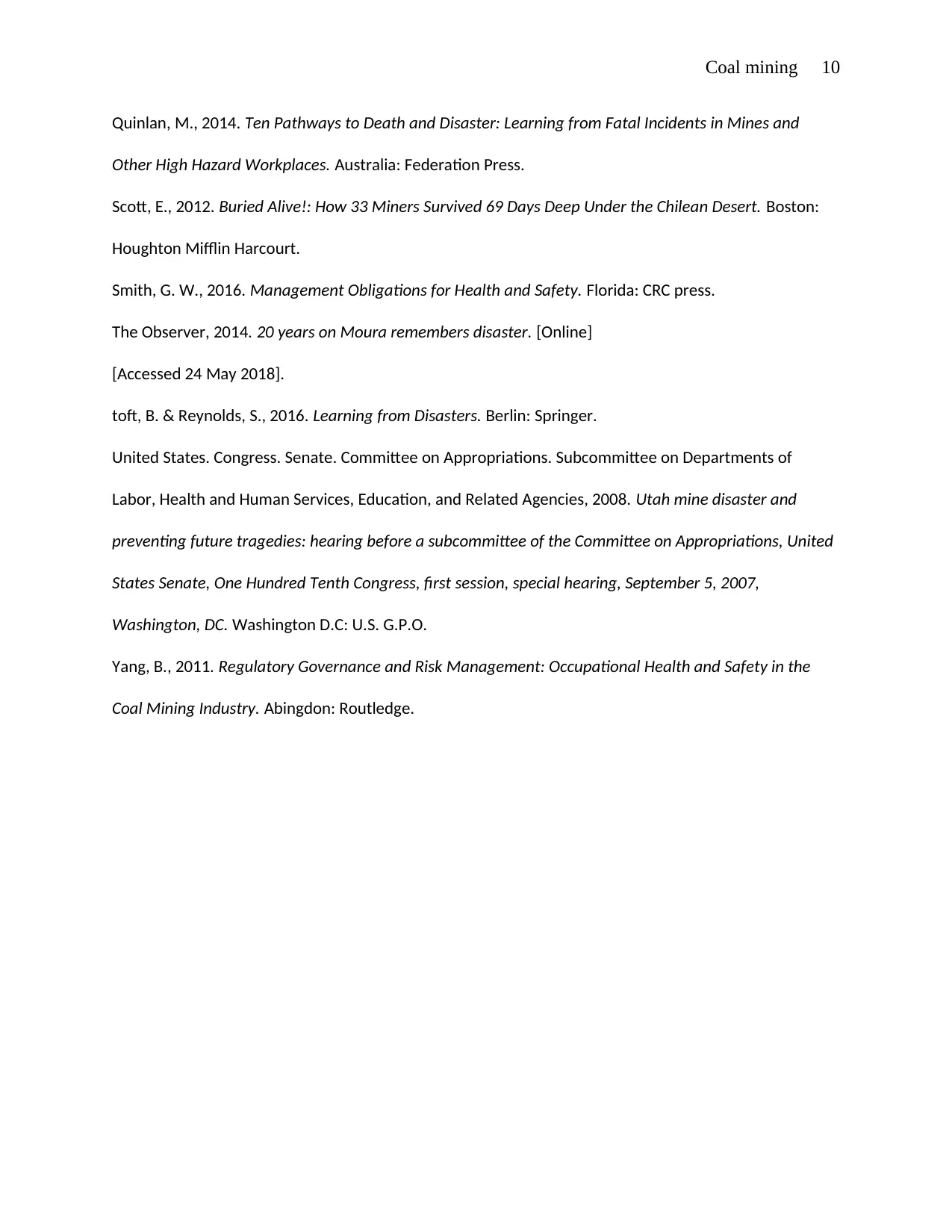
Coal mining 10
Quinlan, M., 2014. Ten Pathways to Death and Disaster: Learning from Fatal Incidents in Mines and
Other High Hazard Workplaces. Australia: Federation Press.
Scott, E., 2012. Buried Alive!: How 33 Miners Survived 69 Days Deep Under the Chilean Desert. Boston:
Houghton Mifflin Harcourt.
Smith, G. W., 2016. Management Obligations for Health and Safety. Florida: CRC press.
The Observer, 2014. 20 years on Moura remembers disaster. [Online]
[Accessed 24 May 2018].
toft, B. & Reynolds, S., 2016. Learning from Disasters. Berlin: Springer.
United States. Congress. Senate. Committee on Appropriations. Subcommittee on Departments of
Labor, Health and Human Services, Education, and Related Agencies, 2008. Utah mine disaster and
preventing future tragedies: hearing before a subcommittee of the Committee on Appropriations, United
States Senate, One Hundred Tenth Congress, first session, special hearing, September 5, 2007,
Washington, DC. Washington D.C: U.S. G.P.O.
Yang, B., 2011. Regulatory Governance and Risk Management: Occupational Health and Safety in the
Coal Mining Industry. Abingdon: Routledge.
Quinlan, M., 2014. Ten Pathways to Death and Disaster: Learning from Fatal Incidents in Mines and
Other High Hazard Workplaces. Australia: Federation Press.
Scott, E., 2012. Buried Alive!: How 33 Miners Survived 69 Days Deep Under the Chilean Desert. Boston:
Houghton Mifflin Harcourt.
Smith, G. W., 2016. Management Obligations for Health and Safety. Florida: CRC press.
The Observer, 2014. 20 years on Moura remembers disaster. [Online]
[Accessed 24 May 2018].
toft, B. & Reynolds, S., 2016. Learning from Disasters. Berlin: Springer.
United States. Congress. Senate. Committee on Appropriations. Subcommittee on Departments of
Labor, Health and Human Services, Education, and Related Agencies, 2008. Utah mine disaster and
preventing future tragedies: hearing before a subcommittee of the Committee on Appropriations, United
States Senate, One Hundred Tenth Congress, first session, special hearing, September 5, 2007,
Washington, DC. Washington D.C: U.S. G.P.O.
Yang, B., 2011. Regulatory Governance and Risk Management: Occupational Health and Safety in the
Coal Mining Industry. Abingdon: Routledge.
1 out of 10
Related Documents
Your All-in-One AI-Powered Toolkit for Academic Success.
+13062052269
info@desklib.com
Available 24*7 on WhatsApp / Email
![[object Object]](/_next/static/media/star-bottom.7253800d.svg)
Unlock your academic potential
© 2024 | Zucol Services PVT LTD | All rights reserved.





